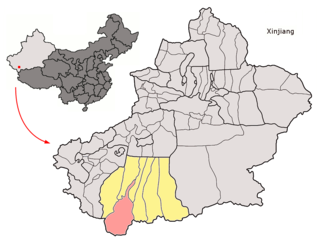
The Hotan River is formed by the union of the White Jade (Yurungkash) and Karakash Rivers, which flow north from the Kunlun Mountains into the Taklamakan Desert in northern China. The two rivers unite towards the middle of the desert, some 145 kilometres (90 mi) north of the town of Hotan. The river then flows 290 kilometres (180 mi) northwards across the desert and empties itself into the Tarim River. Because the river is fed by melting snow from the mountains, it only carries water during the summer and is dry the rest of the year. Prior to construction of the Tarim Desert Highway in 1995, the Hotan river bed provided the only transportation system across the Tarim Basin.

Zepu County as the official romanized name, also transliterated from Uyghur as Poskam County the former longer Chinese name as well, is a county in the Xinjiang Uyghur Autonomous Region and is under the administration of the Kashgar Prefecture. It contains an area of 985 km2 (380 sq mi). According to the 2002 census, it has a population of 180,000.

Moyu County as the official romanized name, also transliterated from Uyghur as Karakax County, is a county in the Xinjiang Uyghur Autonomous Region and is located in the southern edge of Tarim basin, it is under the administration of the Hotan Prefecture. It contains an area of 25,667 km2 (9,910 sq mi). According to the 2011 census it has a population of 577,000 and according to the statistics 98,1% of them are Uyghur ethnic groups.

Hotan Prefecture is located in the south-western part of the Xinjiang Uyghur Autonomous Region, bordering the Tibet Autonomous Region to the south. It is sometimes (unofficially) spelled as Khotan.

Hotan Airport is an airport serving Hotan, a city in the autonomous region of Xinjiang in China.
The National Administration of Cultural Heritage is an administrative agency subordinate to the Ministry of Culture and Tourism of the People's Republic of China. It is responsible for the development and management of museums as well as the protection of cultural relics of national importance.

China National Highway 217 (G217) runs south from Altay, Xinjiang to Hotan, Xinjiang. It is 1,753 kilometres in length and runs southwest from Altay towards Kuqa County and from there southwards through the Taklamakan Desert to Hotan.

The Southern Xinjiang railway or Nanjiang railway is a railway between Turpan and Kashgar in Xinjiang, China. The railway is 1,446 km (899 mi) in length and runs along the southern slope of the Tian Shan mountain range, connecting all major cities and towns of the northern Tarim Basin, including Turpan, Hejing, Yanqi, Korla, Luntai (Bügür), Kuqa, Toksu (Xinhe), Aksu, Maralbexi (Bachu), Artux and Kashgar.

The 2011 Hotan attack was a bomb-and-knife attack that occurred in Hotan, Xinjiang, China on July 18, 2011. According to witnesses, the assailants were a group of 18 young Uyghur men who opposed the local government's campaign against the burqa, which had grown popular among older Hotan women in 2009 but were also used in a series of violent crimes. The men occupied a police station on Nuerbage Street at noon, killing two security guards with knives and bombs and taking eight hostages. The attackers then yelled religious slogans, including ones associated with Jihadism, as they replaced the Chinese flag on top of a police station with another flag, the identity of which is disputed.

The Turpan–Hotan Expressway (Chinese: 吐鲁番—和田高速公路, Uyghur: تۇرپان-خوتەن يۇقىرى سۈرئەتلىك تاشيولى ), commonly referred to as the Tuhe Expressway (Chinese: 吐和高速公路), is a Chinese expressway that connects the G30 Lianyungang–Khorgas Expressway at Xiaocaohu, in Toksun County, Turpan, with China National Highway 315 in Lop County, Hotan Prefecture. The expressway, designated G3012, is a spur of the G30 Lianyungang–Khorgas Expressway and is completely in Xinjiang. It is 1,931 kilometres (1,200 mi) in length.

The Kashgar–Erkeshtam Expressway (Chinese: 喀什—伊尔克什坦高速公路, Uyghur: قەشقەر-ئەركەشتام يۇقىرى سۈرئەتلىك تاشيولى ), commonly referred to as the Kayi Expressway (Chinese: 喀伊高速公路) and designated G3013, is a 213.9-kilometre-long roadway (132.9 mi) in the Chinese autonomous region of Xinjiang. It connects the county-level city of Artux, north of the city of Kashgar, and Erkeshtam, a border checkpoint between China and Kyrgyzstan. The expressway is a spur of the G30 Lianyungang–Khorgas Expressway, however it is only connected to its parent via the G3012 Turpan–Hotan Expressway.

Tianjin Airlines Flight 7554 was a scheduled passenger flight between Hotan and Ürümqi in China's Xinjiang Autonomous Region. The aircraft operating this route on 29 June 2012, an Embraer 190, took off from Hotan at 12:25 pm; within ten minutes, six ethnic Uyghur men, one of whom allegedly professed his motivation as jihad, announced their intent to hijack the aircraft, according to multiple witnesses. In response, passengers and crew resisted and successfully restrained the hijackers, who were armed with aluminum crutches and explosives.
Atlas silk or Etles Silk is a type Ikat Uyghurs used only for woman's clothing. It is kind of silk produced by the atlas moth. One of the largest sites of production is China's far western city of Hotan, and surrounding towns in the Xinjiang Uyghur Autonomous Region.
Ismail Amat was an Uyghur politician of China who served as Chairman (Governor) of Xinjiang Uyghur Autonomous Region, State Councillor, Vice-Chairman of the National People's Congress, and Vice-Chairman of the Chinese People's Political Consultative Conference (CPPCC). He was one of the highest-ranking Uyghur or Muslim politicians of the People's Republic of China.
Adil Nurmemet is a former Chinese politician of Uighur ethnicity. He was the Mayor of Hotan, an important city in the Xinjiang interior, between 2009 and 2013. He was investigated by the Communist Party of China's anti-graft agency in October 2014.

The Hebei Museum is located in Shijiazhuang, the capital city of Hebei Province, China. It first opened in April 1953 in Baoding. After moving twice in the 1980s, it reopened in October 1987 at its present location on South Zhongshan Street. As the only provincial-level museum in Hebei, its primary function is the collection and exhibition of ancient cultural relics.

Kunyu is a county-level city in Xinjiang Uyghur Autonomous Region, China. It is geographically located in Hotan Prefecture of southern Xinjiang, but is directly administered by the Xinjiang regional government.

The Xinjiang Uyghur Autonomous Region Museum, or Xinjiang Museum, is located in Urumqi, Xinjiang, China. Its address is at 581 Xibei Road, Urumqi.
Yutian Airport is an airport scheduled to be built in Yutian County, Hotan Prefecture, Xinjiang, China. The construction budget is CN¥710 million.

















